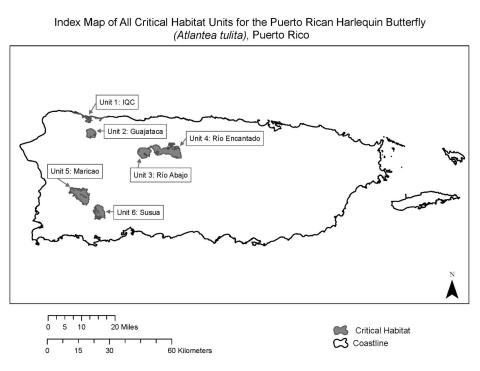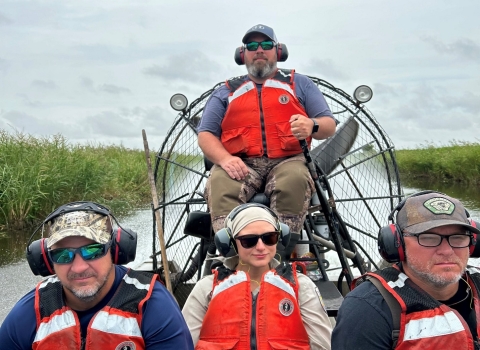What is the Puerto Rican harlequin butterfly and where does it occur?
The Puerto Rican harlequin butterfly is a medium-sized butterfly in the checkerspot family that is native to Puerto Rico. The butterfly’s distribution is fragmented among remnants of native forest in northwestern and central Puerto Rico.
What action is the U.S. Fish and Wildlife Service taking?
Based on a review of the best available scientific and commercial information, the U.S. Fish and Wildlife Service is finalizing the listing of the Puerto Rican harlequin butterfly as threatened under the Endangered Species Act (ESA). The Service is also designating approximately 41,266 acres of critical habitat in Puerto Rico as well as a 4(d) rule that tailors protections for the butterfly while allowing activities that do not harm its recovery.
Why is the Service listing the Puerto Rican harlequin butterfly as a threatened species?
Today, six populations of the Puerto Rican harlequin butterfly are known to exist, each generally small in size with less than 50 adults observed in any given year. Relative to historical conditions, the butterfly’s distribution is fragmented among remnants of native forest located in northwestern and central Puerto Rico.
Habitat modification, fragmentation and losses caused by urban development and agricultural practices are the main reasons for this butterfly’s decline and threats to its continued existence. Other threats affecting the butterfly include human-induced fires, improperly applied pesticides, herbicides and fungicides, and clearing of native vegetation. Small population sizes, which are natural but exacerbated by human-caused threats, along with reduction in range and lack of population connectivity, also threaten the species. Climate change is also considered to be a future threat to the species, with increased temperatures, drought, and storm frequency and intensity projected for Puerto Rico.
How does the ESA define critical habitat?
The ESA defines critical habitat as the specific geographic areas that contain features essential to the conservation of an endangered or threatened species that may require special management and protection. Critical habitat may also include areas that are not currently occupied by the species but will be needed for its recovery.
Establishing critical habitat for the butterfly will alert federal agencies that they are required to make special conservation efforts when they work, fund, or permit activities in these areas. The designation will have no impact on private landowners taking actions on their land that do not require federal funding or permits.
How does the Service determine what areas to designate as critical habitat?
Within areas occupied by the species, biologists consider physical or biological features needed for life processes. These include:
Space for individual and population growth and for normal behavior.
Cover or shelter.
Food, water, air, light, minerals, or other nutritional or physiological requirements.
Sites for breeding and rearing offspring.
Habitats that are protected from disturbances or are representative of the historical geographical and ecological distributions of a species.
After considering occupied areas, biologists consider unoccupied areas that may be essential for the conservation of the species.
What is the critical habitat designation for the Puerto Rican harlequin butterfly?
Critical habitat for the butterfly is limited to occupied areas where the species currently occurs. This includes a two-kilometer buffer around breeding sites. In total, approximately 41,266 acres are being designated – 56 percent in private ownership; 39 percent owned/managed by Puerto Rico Department of Natural and Environmental Resources; and 5 percent other (e.g., municipality, other). Since all critical habitat is currently occupied by the species, most or all of the protections or changes in management will be the same as those provided for the species’ conservation under the ESA. In Maricao, much of this habitat overlaps with locations that are already designated as critical habitat for another species, the elfin woods warbler.
The critical habitat units are in the municipalities of Isabela, Quebradillas, Camuy, Arecibo, Utuado, Florida, Ciales, Maricao, San Germán, Sabana Grande and Yauco. The map below shows where those units are located.
What is a 4(d) rule? Why is this being put in place for the Puerto Rican harlequin butterfly?
For threatened species, the Service uses the flexibility provided under section 4(d) of the ESA to tailor the take prohibitions to those necessary and advisable for the conservation of the species. This targeted approach helps reduce regulatory burdens by exempting certain activities that do not significantly harm the species, or that are beneficial, while focusing conservation efforts on the threats detrimental to recovery.
What protections and prohibitions do the 4(d) rule specify for the Puerto Rican harlequin butterfly?
The 4(d) rule includes all of the prohibitions and the standard exceptions for federal and Commonwealth agency conservation activities. The Service is also including exceptions for incidental take associated with the following activities: (1) normal agricultural practices, including pesticide use, which are carried out in accordance with any existing regulations, permit and label requirements, and best management practices, as long as the practices do not include clearing or disturbing forest or prickly bush to create or expand agricultural areas, or applying pesticides in or contiguous to habitat known to be occupied by the Puerto Rican harlequin butterfly; (2) normal residential and urban activities, such as mowing, weeding, edging, and fertilizing; (3) maintenance of recreational trails in Commonwealth forests; (4) habitat management or restoration activities expected to provide a benefit to the Puerto Rican harlequin butterfly; (5) removal of illicit garbage dumps, which are often the sources of intentionally set fires; and, (6) fruit fly trapping by the U.S. Department of Agriculture’s Animal and Plant Health Inspection Service.
When will this rule become final?
The rule finalizing the listing, critical habitat, and the 4(d) rule for the Puerto Rican harlequin butterfly will become effective on January 3, 2023.




